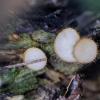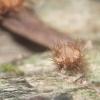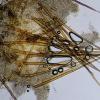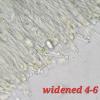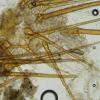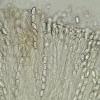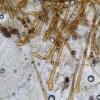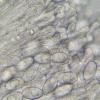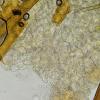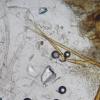
30-12-2025 17:14
 Bernard CLESSE
Bernard CLESSE
Bonjour à toutes et tous,Pourriez-vous aider Albe

29-12-2025 10:15
Hulda Caroline HolteHello, I found and collected this propoloid ascom

30-12-2025 16:44
Pascal DucosBonjour,Une anamorphe rose stipitée, très nombre

30-12-2025 16:41
Pascal DucosBonjour,Une anamorphe rose stipitée, très nombre

30-12-2025 09:04
Hello.A Pyrenomycete sprouting sparsely but very d

29-12-2025 17:44
Isabelle CharissouBonjour,J'aimerais savoir si d'autres personnes au

12-11-2021 00:03
Lepista ZacariasHi everybody,A week ago in my fiels trip I noticed
Lasiobolidium boudieri?
Karl Soler Kinnerbäck,
10-01-2024 12:31
FROM DRIED MATERIAL:
Hairs up to 1000 long and 30 wide at the base, septate and rooted.
Spores measure 18-21 x 10, with or without guttules. Could not find a gelatinous sheath.
Paraphyses widened to 4-6 at apex which does not match with the description(?), which states filiform, only slightly widened apex.
Could it be L. boudieri or something similar?
Best regards
Karl
Valencia Lopez Francisco Javier,
14-01-2024 17:01
Re : Lasiobolidium boudieri?
Hola Karl
Si, esto es un Lasiobolidium, por el tamaño esporal también diría que se trata de L. boudieri, los pelos del margen suelen ser muy variables en tamaño, pero se conocen colecciones con tamaño superior a loas 1000um, el contenido esporal suele ser granular, pero cuando son inmaduras presentan pequeñas gotitas y cuando las esporas están muertas se fusionan en una o en dos gutulas más grandes, también se conocen bases bifurcadas en los pelos del margen.
L. parvisporum tiene esporas más pequeñas 16,2 - 17,7 x 10,4 - 12,2 y pelos marginales más cortos también, de hasta 500um.
L. trachysporum tiene esporas con finas verrugas y como en Trichophaeosis bicuspis le gusta los lugares donde crecen Populus alba y P. nigra.
Tienes una buena descripción de estas especies en el artículo de Ascomycete.org: Exploring the European Trichophaea-Like discomycetes (Pezizales) using morphological and molecular data.
Saludos
Curro Valencia
Si, esto es un Lasiobolidium, por el tamaño esporal también diría que se trata de L. boudieri, los pelos del margen suelen ser muy variables en tamaño, pero se conocen colecciones con tamaño superior a loas 1000um, el contenido esporal suele ser granular, pero cuando son inmaduras presentan pequeñas gotitas y cuando las esporas están muertas se fusionan en una o en dos gutulas más grandes, también se conocen bases bifurcadas en los pelos del margen.
L. parvisporum tiene esporas más pequeñas 16,2 - 17,7 x 10,4 - 12,2 y pelos marginales más cortos también, de hasta 500um.
L. trachysporum tiene esporas con finas verrugas y como en Trichophaeosis bicuspis le gusta los lugares donde crecen Populus alba y P. nigra.
Tienes una buena descripción de estas especies en el artículo de Ascomycete.org: Exploring the European Trichophaea-Like discomycetes (Pezizales) using morphological and molecular data.
Saludos
Curro Valencia
Karl Soler Kinnerbäck,
18-01-2024 10:39
Re : Lasiobolidium boudieri?
Thanks alot! The species seems new to Sweden so I appreciate your confirmation. Yes I used the article you reference as the basis for my ID suggestion, as well as your previous articles.
Best regards
Karl
Best regards
Karl



